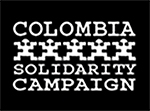In the coca growing regions of southern Colombia more than coca is being eradicated by the U.S.-sponsored aerial fumigation. While the spraying has eradicated thousands of acres of coca, it has also destroyed the food crops and livelihood of impoverished farmers in the targeted regions. More than one and a half years after its implementation, it has become evident that Plan Colombia is failing to achieve any of its stated objectives – boosting Colombia's economy, ending the civil conflict, and dramatically curtailing the flow of drugs to the US.
The Colombian economy has stagnated, with unemployment hovering near 18 percent. The economic austerity measures imposed on Colombia by the IMF in return for a $2.7 billion loan in December 1999 – an economic component of Plan Colombia – have only aggravated conditions for the 64 percent of the population that lives in poverty.
The collapse of the Pastrana administration's peace talks with the Revolutionary Armed Forces of Colombia (FARC) in February has resulted in an escalation of the civil conflict and the Bush administration has responded to the growing crisis by expanding its military involvement from counternarcotics to counterinsurgency operations.
Plan Colombia has also failed to diminish drug production. Despite record amounts of acres having been fumigated during the past 20 months, figures released by the White House's Office of National Drug Control Policy show a 25% increase in illicit crop cultivation last year.
Plan Colombia's initial six-week spraying campaign was launched in Putumayo in December 2000 and not only resulted in the destruction of 62,000 acres of coca, it also devastated food crops and adversely affected the health of local children. Even farmers who had signed social pacts to voluntarily uproot their coca plants in return for $1,000 in materials, technical assistance, and a promise that they would not be fumigated, stood by helplessly as the spraying killed their newly planted alternative crops.
The devastation led to protests by thousands of campesinos and the governors of the six southern departments affected by the fumigations. The government agreed that in future PLANTE, the agency in charge of the alternative crop program, would inform the National Anti-Narcotics Directorate of the location of farmers who had signed social pacts.
But there is already evidence that the latest spraying campaign, launched in Putumayo on July 28, has also destroyed alternative crops. Victoriano, a Putumayo farmer who signed a social pact four months ago, replaced his coca plants with lulo fruit plants used to make juice drinks. In August, his newly planted crops were destroyed by the fumigation. Meanwhile, two nearby coca fields were scarcely affected.
The US State Department recently released the results of a study conducted on its behalf by the Environmental Protection Agency (EPA) that was based on, as incredible as it sounds, guidelines and information provided by the State Department. The report proved inconclusive, primarily because the EPA could not accurately determine the effects of the particular herbicide mix used in Colombia's remote tropical regions, and had to base its report on studies of glyphosate usage in the US.
However, the report does point out that glyphosate usage in the US occurs in agricultural areas "employing crop varieties that have been developed to be resistant to glyphosate." In contrast, Putumayo's foods crops have no protection against glyphosate.
In terms of human health consequences, the EPA report claimed that the current concentration of glyphosate causes acute eye irritation and recommended that the State Department "consider using an alternative glyphosate product (with lower potential for acute toxicity)." In response, the State Department announced that it will soon begin spraying with a less toxic form of glyphosate.
The same day the State Department delivered its spraying report to Congress, counternarcotics officials in Colombia announced that they intend to increase the concentration of glyphosate used in the herbicide mix by 25 percent, offsetting the benefit of spraying a less toxic glyphosate product.
Even when the alternative crops of local farmers manage to survive the fumigation, the social pacts have often provided insufficient resources to maintain a family. According to one local official, "There was a lot of corruption as NGOs from Bogotá invaded Putumayo. We know how to work with the people in Putumayo, but with Plan Colombia came a lot of people from other places to manage the projects and the government only gave the money to these organizations."
Such accusations of corruption and waste were echoed by Jair Giovani Ruiz, an agro-industrial engineer with the Ministry of the Environment's Corpoamazonia (Corporation for Sustainable Development in the Southern Amazon), who claims that campesinos have received little of the alternative crop funding.
While the 20 percent of U.S. aid going to social and economic development programs has proven woefully inadequate and is disbursed too inefficiently to implement effective long-term alternative crop strategies, the other 80 percent of Plan Colombia aid has proven very effective at destroying the livelihoods of all campesinos living in the areas of fumigation.
To make matters worse, the recent expansion of the U.S. military role to counterinsurgency operations under the guise of the "war on terrorism" means that the U.S.-trained counternarcotics brigade can now be used to combat Colombia's two leftist guerrilla groups. There is already evidence of collusion between the new U.S.-trained counternarcotics brigade and right-wing paramilitary death squads.
In one recent incident on the outskirts of Puerto Asis, an army patrol consisting of soldiers from the U.S.-trained counternarcotics brigade allowed four paramilitaries to pass unhindered and then watched as they prepared to board canoes on the Putumayo River. That same night, a paramilitary death squad killed three unarmed civilians in Puerto Asis. Two were shot in the head, while the third was hacked to death with a machete.
So far, the enormous U.S. contribution to Plan Colombia has succeeded only in creating an environment in which Washington can now justify further escalating its military intervention in Colombia's civil conflict. As Mario Cabal of PLANTE succinctly stated, "We have money for helicopters and arms for war, but we don't have money for social programs."
Garry Leech
This is an abridged verion of the article that is published on www.colombiareport.org

